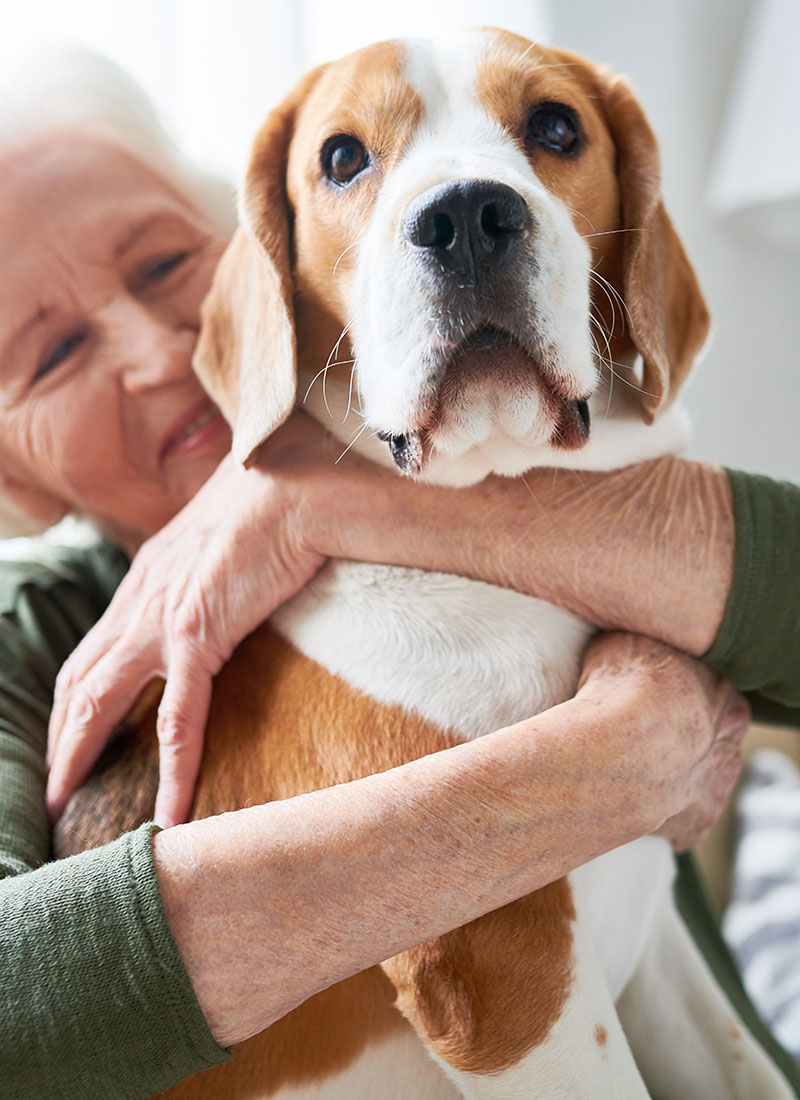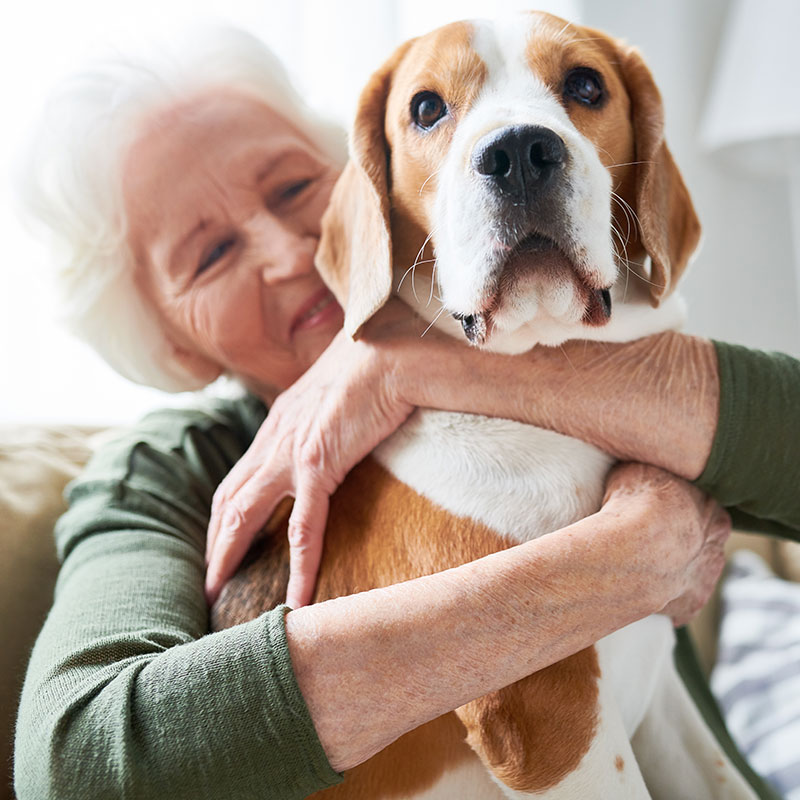



Worried about your dog getting old?
In this week’s article, we look at aging in dogs, with a special focus on canine dementia.
How old is your dog?
Puppy? Adolescent? Adult? Or one of the millions of senior (7-8+ years) and geriatric (11+ years) dogs living in the UK today? N.B.The wide variety of dog breed/shapes/sizes means some dogs age faster than others (e.g. giant breeds tend to live shorter lives and age more rapidly), but it is generally accepted that dogs over the age of 7 or 8 fall into the senior group.
Our pets are living longer than ever due to the fantastic healthcare and lifestyles we now provide them with4,5, so it comes as no surprise that they are showing the same set of age related health conditions we see in older humans. How many of the following does your older doggy show?
- Stiff joints, loss of mobility, slower on their walks and less playful
- Increasing tiredness, lack of energy, sleeping more in the day
- Confusion, forgetfulness and staring into space
- Issues with hearing and sight loss
- Personality changes
- Appetite changes
- Incontinence

Old Age Is Not A Disease
As vets, we increasingly see dogs and cats in our clinics of advanced years, many of whom present with at least one symptom of ‘old age’. Sometimes we see older dogs with health conditions which have been left unchecked because owners regard them as ‘normal for an older dog’ and either assume nothing can be done to help, or are fearful that their vet will offer only drastic and expensive solutions to the problem. It is important not to simply put health problems down to ‘old age’ and allow them to persist or deteriorate when there are often many ways to improve, if not cure, these symptoms.
Typical health issues seen in older pets…
- Joint/mobility issues
- Brain/cognition problems
- Heart/respiratory concerns
- Gut/digestive upsets
- Liver/kidney changes
- Hearing/sight loss
- Incontinence

Canine Dementia
One condition which commonly occurs as dogs age, is canine dementia or CCD. Canine cognitive dysfunction syndrome (CCD) affects up to 60% of older dogs, mostly dogs older than 11 years1. The condition is similar to Alzheimer’s in humans and clinical signs can be noticeable from 8 years upwards. It is a progressive, age-related, neurodegenerative condition that affects cognitive function. We are still not 100% sure of the causes of CCD, but it is thought to be related to chemical and physical changes in the brain linked to free radicals and a protein called amyloid-β.
Common signs of CCD include1,7,8,9…
- Sleep Wake Changes: Sleeping more in the day and being restless at night
- Interactivity Changes: Less social interaction with owners and other familiar people and pets, avoidance of petting or seeking more contact and attention from owners
- Disorientation: Aimless wandering and pacing, getting ‘lost’ in the home, staring into space, engaging in repetitive or incomplete behaviours.
- Memory Loss: Failure to perform previously known obedience behaviours, failure to recognise familiar people/animals
- Toileting in the House: Failing to ask to go out to toilet or toileting upon return to the house
- Anxiety: Increased anxiety in a variety of situations, often where there was no previous anxiety.
Many owners understandably confuse symptoms of CCD with regular behaviour changes or simply ‘old age’ in their pet6, which may account for the condition’s high rate of under-diagnosis2. And owners aren’t the only ones missing the signs, it is thought that as many as one in seven cases even go undiagnosed by vets3! Further complicating matters is the fact that certain behavioural symptoms associated with CCD are similar to symptoms of other medical problems (e.g. toileting in the house and incontinence), hence medical issues must be ruled out before a diagnosis of CCD can be achieved.
If you would like to check if your dog is showing signs of cognitive decline, click this link and check for symptoms in your pet13. The linked questionnaire allows you to add up the signs of cognitive dysfunction in your dog and will tell you whether it is time to speak with your vet about your older dog’s health.
Caring For An Older Dog
Irrespective of whether your dog has signs of CCD, there are simple strategies you can take to help ensure good quality life in your dog’s later years.
 Nutrition
Nutrition
Digestion & Immunity
As dogs age, their digestive/immune system becomes less efficient. This means they can be more prone to digestive upsets and tend not to get as much goodness out of the food they eat. A variety of life stage diets therefore target senior dogs with nutrition tailored to meet these needs. In addition, some senior foods look to target specific health conditions e.g. joint or cognitive issues. N.B. We would always advise making any transition to a new diet slowly, to avoid issues with digestive upset or palatability.
Oral Health
The oral health of dogs tends to decline over time so if it is possible to brush your dog’s teeth and take care of their oral hygiene, please do so. If their oral health is already poor (clues to this include if your dog has bad breath, is struggling to bite or chew their food, or if you can visibly see that their teeth are discoloured and their gums are red) then it is important to speak to your vet about the need for cleaning the teeth under anaesthetic. Whilst this may seem like a drastic step, studies have shown that dental disease has a negative impact on the general health of dogs and that their quality of life is improved once rotten and painful teeth have been removed.
Bodyweight
Older dogs can be prone to gaining weight. It is therefore critical that you adapt the type and volume of food your dog eats in response to their changing levels of energy and exercise and their advancing years. If you are unsure if your dog is under or overweight simply ask your vet/vet nurse. Many surgeries run free weight clinics and offer free weight loss advice for pets.
Supplements
Many natural ingredients have specific health benefits for older pets. They often target the body’s inflammatory response, levels of free radicals, cell metabolism, neurological signalling and cell health11, 12. One of the main benefits of supplements is that they tend to have limited to no side-effects and so can be used safely long-term. Examples of beneficial ingredients for senior pets include...
- Glucosamine, MSM and chondroitin for joint and cartilage support
- Ginseng, Immortality herb, Vitamin B6, Selenium and L-carnitine for cognitive support
- Omega 3 EFAs from fish oils for all round support of joints, heart, brain and kidneys.
- Antioxidants like Vitamin E to neutralise the free radicals which increasingly build up as the body ages and support healthy liver function.
Supplements have been shown to have a positive impact on the health of dogs with CCD and joint issues and can be used successfully in combination with other management strategies6.
 Environmental Adaptations & Enrichment
Environmental Adaptations & Enrichment
Simple adaptations can be made to the environment of older doggies to make their life a little easier.
Mobility
Consider using ramps to help them climb steps that they regularly access or to get in and out of the car or place non-slip mats and carpet on areas of tiled or wood flooring which your dog struggles to stand up on if their legs are weaker.
Treat them to a gentle leg massage before heading out on walks as this helps get their legs moving and improves range of motion in stiff joints and opt for little and often walks instead of occasional long walks help dogs to maintain muscle strength and joint mobility.
Routine
Maintain as consistent a routine as possible at home with regard to feeding, play and exercise and consider whether it is more appropriate to have a house sitter take care of your pet when you go away than placing them in kennels1.
Time Alone
No animal should be left alone for extended periods of time but with senior doggies this is even more relevant. They may struggle to wait until you return to toilet and can become disorientated and anxious if they are left alone too long. Avoid long periods of absence and arrange for a pet sitter to visit if you need to be away longer than normal.
Training
Continue to reinforce basic training with them as they may forget things they learnt previously and if their hearing is deteriorating, adapt their training to include hand gestures as opposed to only voice commands. Behavioural enrichment in the form of food puzzles, novel toys and reinforcement of basic training is beneficial, as is social enrichment via positive interaction with animal and human friends but try to introduce new toys and interactions slowly to avoid stress10.
Exercise
Maintain a healthy and stimulating lifestyle for your dog that suits their level of mobility as this will help to slow the progression of cognitive decline and keep them as fit as possible. Regular play with little and often exercise (even in those dogs with mobility issues) helps keep them mentally and physically fit for longer. Speak to your vet or a veterinary physiotherapist about exercises you can do with your pets as they get older if you are unsure.
If your pet suffers from hearing or sight loss it may no longer be safe to allow them to explore widely off the lead with you on walks, as they may become lost or may not respond to your recall. Use common sense and only allow them off the lead if you are happy the area you are in is safe or make use of longer extendable leads so they can explore but are still connected to you.
Avoid Stress
Dogs with CCD are less able to cope with stressors or novel environments and experiences so avoid unnecessary stress and make any lifestyle changes slowly10.
 Medicines
Medicines
There comes a point in the lives of most dogs where their chronic health conditions such as joint stiffness or cognitive decline can benefit from the use of prescribed medication. Owners can be reluctant to use medication because of fear of side-effects, but your vet will help you to balance the good impact of these drugs with the side-effects to allow you to give your pet the best possible quality of life. Examples of medications which are commonly used in older pets include non-steroidal anti-inflammatory drugs to manage inflammation and MAO-B inhibitors used for the treatment of CCD.
 Healthcare
Healthcare
Check Ups
When your dog was a fit healthy adult, visits to the vet probably only happened for routine vaccinations or if your pet suddenly fell ill or had an accident. Now that your dog is older it is important to consider the value of having routine maintenance check-ups more frequently than yearly. As dogs age faster than humans (it is often quoted that one dog year is the equivalent of seven human years) a year in the life of an older dog can represent a considerable period of lifespan, in which their health can change. Opting for six monthly or even quarterly vet/vet nurse checks is a great way to spot the early signs of health conditions such as heart problems and allows you to keep a close eye on any changes in bodyweight.
Tests
Undertaking simple non-invasive tests such as urinalysis is inexpensive and helps detect early signs of conditions like kidney dysfunction. It is also a good idea to consider routine blood tests when your dog is at the vets for their annual vaccinations, even if they are showing no signs of a health problem. This is because many conditions will only show clinical signs when they are at an advanced stage.
Don’t Delay
Seek veterinary help in a timely manner if you spot any changes in your older pet, physical or mental. With all health problems in older pets, the sooner we intervene the better the chances are that your vet can help resolve or manage the issue. Acting early gives your senior dog and you, the best possible quality of life together!
REFERENCES
1. Fast, R., Schütt, T., Toft, N., Møller, A., & Berendt, M. (2013). An Observational Study with Long-Term Follow-Up of Canine Cognitive Dysfunction: Clinical Characteristics, Survival, and Risk Factors. Journal of Veterinary Internal Medicine, 27(4), 822-829.
2. Hamnilrat, T., Lekcharoensuk, C., Choochalermporn, P., & Thayananuphat, A. (2015). Flash Visual Evoked Potentials in Normal Pomeranian Dogs and Those with Canine Cognitive Dysfunction. Thai Journal of Veterinary Medicine, 45(3), 323-329.
3. Salvin, H. E., McGreevy, P. D., Sachdev, P. S., & Valenzuela, M. J. (2010). Underdiagnosis of canine cognitive dysfunction: A cross-sectional survey of older companion dogs. The Veterinary Journal, (183)3), 277-281.
4. Katina, S., Farbakova, J., Madari, A., Novak, M., & Zilka, N. (2016). Risk factors for canine cognitive dysfunction syndrome in Slovakia. Acta Veterinaria Scandinavica, 581-7.
5. McGreevy, P. D., and Bennett, P. C. (2010). Challenges and paradoxes in the companion-animal niche. Animal Welfare, 19, 11-16.
6. Chapagain D et al (2018). Cognitive Aging in Dogs. Gerentology. Feb; 64(2): 165-171
7. Cory, J. (2013). Identification and management of cognitive decline in companion animals and the comparisons with Alzheimer disease: A review. Journal of Veterinary Behavior: Clinical Applications and Research 8(4), 291-301.
8. Schutt, T., Toft, N., Berendt, M. (2015). A comparison of 2 screening questionnaires for clinical assessment of canine cognitive dysfunction. Journal of Veterinary Behavior: Clinical Applications and Research, 452-458.
9. Madari, A., Farbakova, J., Katina, S., Smolek, T., Novak, P., et al. (2015). Assessment of severity and progression of canine cognitive dysfunction syndrome using the CAnine DEmentia Scale (CADES). Applied Animal Behaviour Science, 171 138-145.
10. Landsberg, G. (2005). Therapeutic agents for the treatment of cognitive dysfunction syndrome in senior dogs. Progress in neuro-psychopharmacology and biological psychiatry, 29(3), 471-479.
11. Fahnestock, M., Marchese, M., Head, E., Pop, V., Michalski, B., et al. (2012). BDNF increases with behavioural enrichment and an antioxidant diet in an aged dog. Neurobiology of Aging (33), 546-554.
12. Milgram, N. W., Head, E., Zicker, S. C., Ikeda-Douglas, C. J., Murphey, H., et al. (2005). Learning ability in aged beagle dogs is preserved by behavioral enrichment and dietary fortification: a two-year longitudinal study. Neurobiology of Aging 26(1), 77-90.
13. Salvin, H. E., McGreevy, P. D., Sachdev, P. S., & Valenzuela, M. J. (2011). The canine cognitive dysfunction rating scale (CCDR): A data-driven and ecologically relevant assessment tool. Veterinary Journal, 188(3), 331-336.
CONTACT
Copyright © Natural VetCare 2019
Security & Privacy | Cookies | Terms & Conditions





